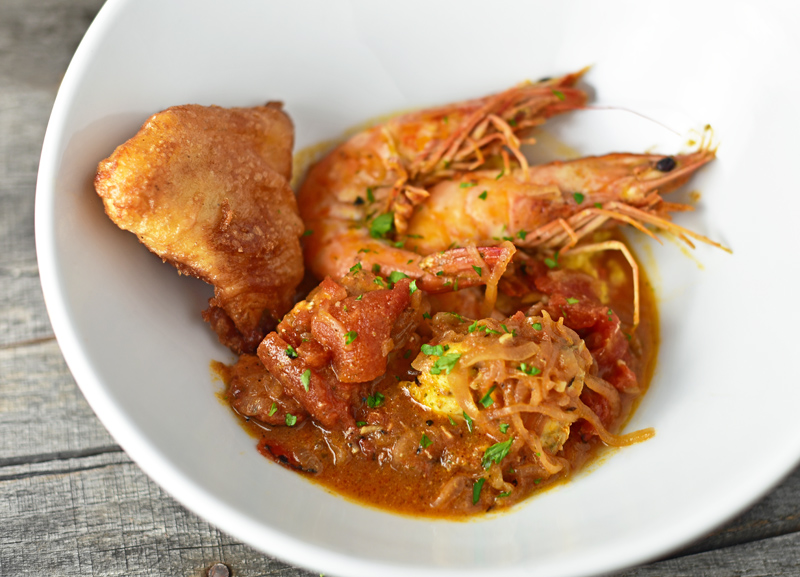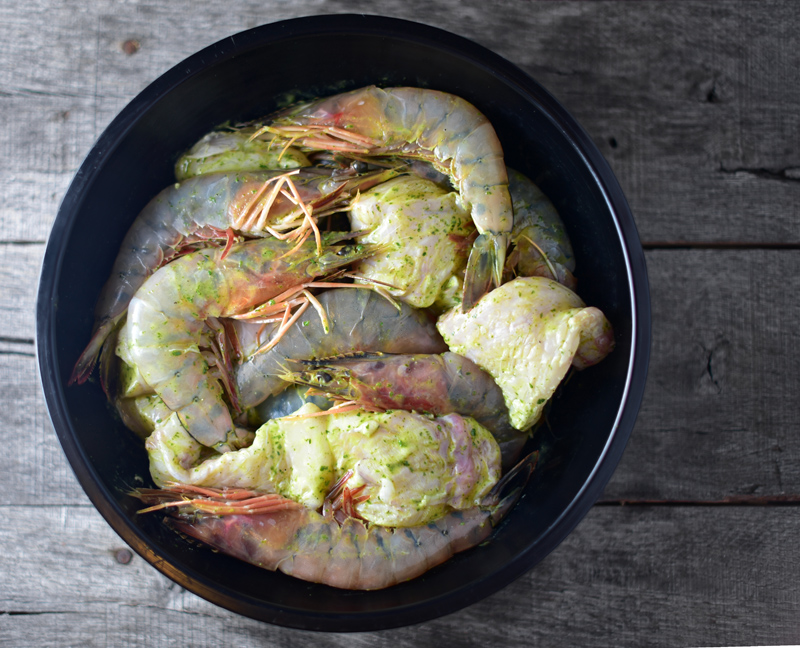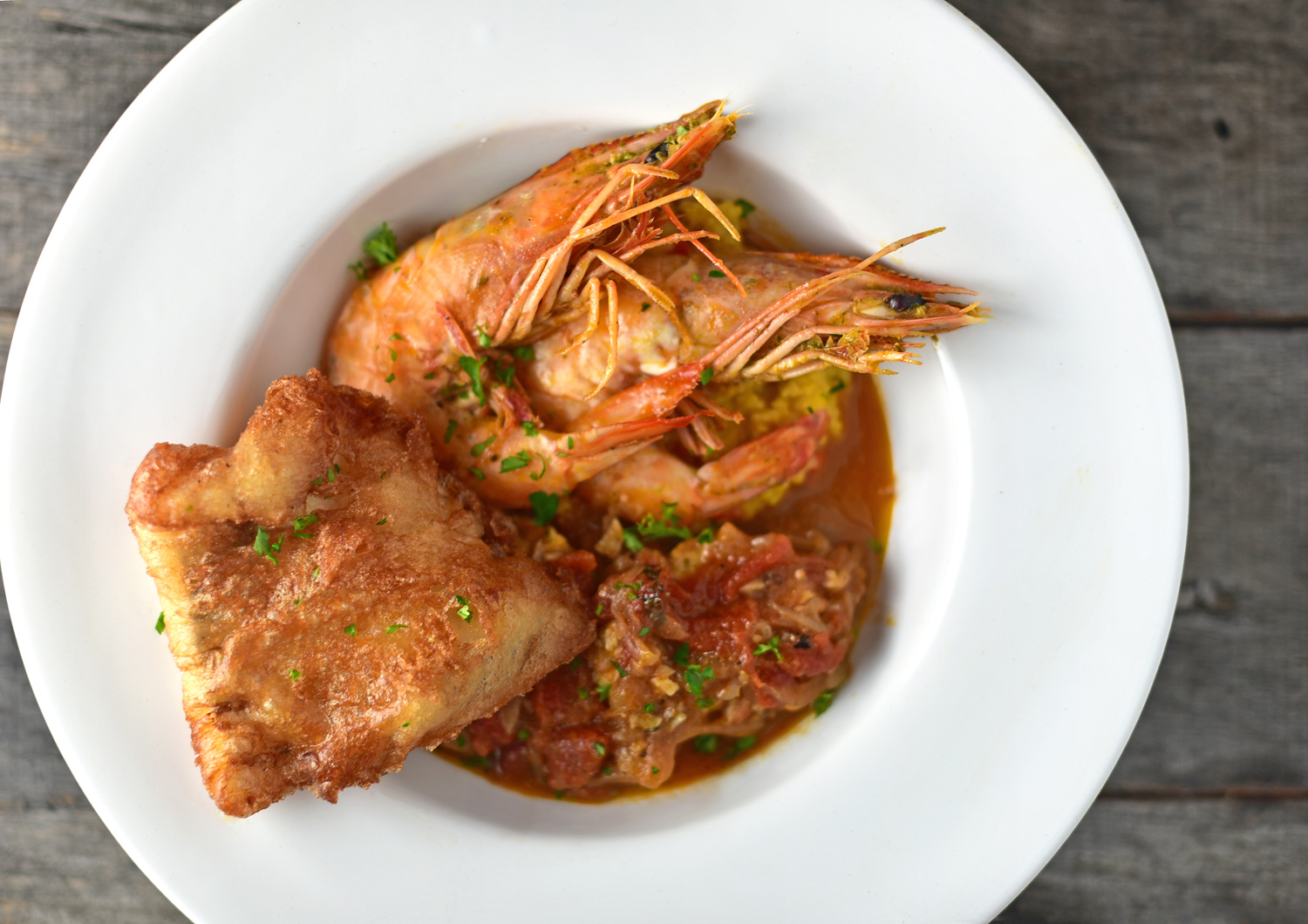In most people’s consciousness, Eastern Europe does not evoke delicious seafood dishes. Apart from caviar or smoked fish (which most people actually eat rarely), the images that come to mind tend to be of thick brown meat stews and starchy dishes, or perhaps of various grilled meats and greasy sausages, washed down with a profusion of beer and other alcoholic beverages. And yet, if you look further south, there’s another Eastern Europe altogether, one that borders the Adriatic on one side and the Black Sea on the other. Take Croatia, for example, which claims the largest share of the eastern Adriatic coast — just look at a map, and you’ll see that nearly half of the country is seaside, including the Dalmatian Coast with its vast number of small islands. People there have access to the same fish as Italy just across the way, and in some cases, they even make the same dishes!
And that’s what happens with brodet, called brodetto in Italian. Despite regional variations in both countries, it remains a stew prepared with assorted local fish and shellfish, tomato, and garlic, cooked in a single pot without stirring. In Croatia, it’s often served with polenta to soak up some of the fish broth. Want to see how it’s made? Check out this video, from Australia of all places.
So here you go, a Croatian dish made by a French guy who lives in America and saw a recipe on Australian TV. Needless to say nobody in Croatia’s ever eaten a brodet like mine. But let me tell you, they don’t know what they’re missing — this is one damn fine brodet, and here’s why:
- It all starts with the seafood, of course. I’m using some of my favorite fish, conveniently available both from the Adriatic and from my online grocery store: turbot, for its great taste and texture, and monkfish, one of the few fishes that work great in stews. These may not be the most frequent species you’ll see at the Croatian markets, but they’re there. In the shellfish department, my beautiful extra-colossal shrimp (I know, it’s a ridiculous name, but that’s the official term) bring flavor to the broth and pair perfectly with the tomato and garlic. If you think there needs to be more variety, consider adding a few mussels too; I’m happy with few ingredients, well distinguishable, but I admit one would have to be seriously impaired to mistake a mussel for a piece of fish, either in appearance or taste.
- Speaking of the shrimp, it’s important to use whole, head-on shrimp, as the heads bring a lot of flavor. Peeling a shrimp while leaving the head on can be a bit tricky, not because it requires a special technique that I know of, but because the head becomes quite loose. It might still be worth the effort, as it makes the meal significantly less messy for your diners (the shrimp in my pictures aren’t peeled). If you do peel them, you can also use the shells to flavor the brodet. For example: sauté the shells in a little bit of olive oil, add the vegetable stock from the recipe (adding extra to factor in evaporation), cover, simmer for 30 minutes, then strain.
- I’m keeping the traditional polenta, but using a variation of the recipe that I already blogged about here. Once you’ve tried it, it’s hard to go back to anything else. Shouldn’t polenta, which is cornmeal, always taste like corn? Granted, it may not absorb a lot of the broth, but that’s what spoons are for.
- One last trick… This is the detail that’s gonna have the brodet purists turning in their graves: my turbot is deep-fried. This isn’t just a nod to Heston Blumenthal’s fish and chips from In Search of Perfection; it also brings more textures to the dish, and prevents the turbot from being lost among the other flavors by protecting it with a shell of a crispy, boozy batter made with hard cider and vodka. Because seafood can be consumed with a profusion of alcoholic beverages, just like any other Eastern European dish.

Pressure-cooked red pepper polenta
Yields about 6 servings
1 red pepper (about 250 g)
40 g butter
125 g dry polenta
420 g corn juice (obtained by juicing corn kernels in a juice extractor)
105 g water
salt
black pepper, ground
- Char the red pepper using a blow torch, then peel off the skin, using a paper towel to rub off the stubborn bits. Remove and discard the core and seeds, and cut into a brunoise. Measure 140 g and reserve.
- Melt the butter in a small saucepan over medium heat. Add the polenta, and toast for 4 minutes until golden brown, stirring constantly.
- Transfer the polenta to three one-pint Mason jars (about 500 ml each). Cover with the corn juice and water, and mix with a fork. Tightly close the jars, then reopen the lids by just a quarter of a turn. Place the jars on a steam rack in a pressure cooker with about 1 cm of water. Close the cooker, bring to pressure, and cook for 12 minutes.
- Depressurize the pressure cooker, and open the lid to release the steam. Reserve in a warm place.
- Before serving, transfer the polenta to a bowl, mix in the red pepper brunoise, and season with salt and pepper.
Brodet
Yields 6 servings
120 g olive oil
60 g lemon juice
12 g parsley leaves
6 g salt
0.5 g ground black pepper
2 g sweet paprika
950 g cleaned monkfish fillets, cut into cubes
12 extra-colossal shrimp (about 75 g each), peeled but with heads on
380 g peeled onions, thinly sliced
18 g peeled garlic cloves, minced
250 g white wine
650 g canned tomatoes, peeled, with their liquid
150 g vegetable stock
6 cherry tomatoes
- In a blender, pulse half of the olive oil with the lemon juice, parsley, salt, black pepper, and sweet paprika. Transfer to a bowl, and toss the monkfish and shrimp in the marinade. Cover with plastic wrap, and refrigerate for 1 hour.
- In a pot over medium heat, sauté the onion and garlic in the rest of the olive oil for about 10 minutes, until soft. Add the white wine, and simmer for a few minutes, until reduced to about 1/4.
- Add the (peeled!) canned tomatoes with their liquid and the vegetable stock. Bring to boil, and simmer for 10 minutes without stirring.
- Add the monkfish, and simmer for another 15 minutes. Don’t stir — a brodet is never stirred. Instead, shake the pot, which will help to distribute heat while still preserving the layers. This is also a good place to pause until you’re ready to assemble the dish.
- Before serving, add the shrimp, the cherry tomatoes, and any remaining liquid from the marinade. Turn the heat up to high (to emulsify the sauce), and cook for 5 minutes, without covering. Serve immediately.

Cider-and-vodka batter
Yields 6 servings
300 g AP flour, sifted
5.5 g baking powder
10 g honey
150 g vodka
300 g hard cider
- In the bowl of an electric mixer fit with the paddle attachment, mix the flour, baking powder, honey, and vodka on medium speed. Add the hard cider and mix again.
- Transfer to a 1 liter siphon, and charge with three cartridges of C2O (the soda ones, not the ones you use for whipped cream). Refrigerate for at least 30 minutes.
Cider-and-vodka-battered turbot
Yields 6 servings
canola oil, for deep-frying
330 g cleaned turbot fillets (in my case, from one 1250 g whole turbot)
salt
black pepper, ground
Wondra flour
turbot batter, in siphon
- Heat the canola oil to 220 C / 425 F in a deep fryer (or a large pot).
- Cut the turbot into 6 pieces. Season with salt and pepper, then sprinkle with Wondra flour on both sides.
- Shake the siphon. In a bowl, release just enough batter to coat one piece of fish. Dip the fish in the batter until fully coated, and gently drop into the frying oil. Repeat with the remaining pieces of fish. When the turbot is golden brown on all sides (which requires flipping it, of course), remove from the oil using a skimmer, and drain on paper towels. The turbot’s internal temperature should be around 40 C / 105 F when you take it out, and it will go up to 45 C / 115 F.
- Proceed with assembly immediately.
Assembly
Yields 6 servings
brodet
pressure-cooked polenta
cider-and-vodka-battered turbot
chopped parsley
- Finish the brodet as explained above.
- Finish the polenta as explained above.
- Divide the polenta between six soup bowls. Top each bowl with two shrimp, some monkfish, and a piece of turbot. Add the liquid from the brodet, and sprinkle with chopped parsley. Serve immediately.


